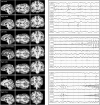Multisite thalamic recordings to characterize seizure propagation in the human brain
- PMID: 37137813
- PMCID: PMC10316776
- DOI: 10.1093/brain/awad121
Multisite thalamic recordings to characterize seizure propagation in the human brain
Abstract
Neuromodulation of the anterior nuclei of the thalamus (ANT) has shown to be efficacious in a subset of patients with refractory focal epilepsy. One important uncertainty is to what extent thalamic subregions other than the ANT could be recruited more prominently in the propagation of focal onset seizures. We designed the current study to simultaneously monitor the engagement of the ANT, mediodorsal (MD) and pulvinar (PUL) nuclei during seizures in patients who could be candidates for thalamic neuromodulation. We studied 11 patients with clinical manifestations of presumed temporal lobe epilepsy (TLE) undergoing invasive stereo-encephalography (sEEG) monitoring to confirm the source of their seizures. We extended cortical electrodes to reach the ANT, MD and PUL nuclei of the thalamus. More than one thalamic subdivision was simultaneously interrogated in nine patients. We recorded seizures with implanted electrodes across various regions of the brain and documented seizure onset zones (SOZ) in each recorded seizure. We visually identified the first thalamic subregion to be involved in seizure propagation. Additionally, in eight patients, we applied repeated single pulse electrical stimulation in each SOZ and recorded the time and prominence of evoked responses across the implanted thalamic regions. Our approach for multisite thalamic sampling was safe and caused no adverse events. Intracranial EEG recordings confirmed SOZ in medial temporal lobe, insula, orbitofrontal and temporal neocortical sites, highlighting the importance of invasive monitoring for accurate localization of SOZs. In all patients, seizures with the same propagation network and originating from the same SOZ involved the same thalamic subregion, with a stereotyped thalamic EEG signature. Qualitative visual reviews of ictal EEGs were largely consistent with the quantitative analysis of the corticothalamic evoked potentials, and both documented that thalamic nuclei other than ANT could have the earliest participation in seizure propagation. Specifically, pulvinar nuclei were involved earlier and more prominently than ANT in more than half of the patients. However, which specific thalamic subregion first demonstrated ictal activity could not be reliably predicted based on clinical semiology or lobar localization of SOZs. Our findings document the feasibility and safety of bilateral multisite sampling from the human thalamus. This may allow more personalized thalamic targets to be identified for neuromodulation. Future studies are needed to determine if a personalized thalamic neuromodulation leads to greater improvements in clinical outcome.
Keywords: corticothalamic interaction; epilepsy; evoked potentials; multisite thalamic recordings; neuromodulation; stereo-encephalography.
© The Author(s) 2023. Published by Oxford University Press on behalf of the Guarantors of Brain. All rights reserved. For permissions, please e-mail: journals.permissions@oup.com.
Conflict of interest statement
The authors report no competing interests.
Figures



Comment in
-
Thalamic stereo-EEG in epilepsy surgery: where do we stand?Brain. 2023 Jul 3;146(7):2663-2665. doi: 10.1093/brain/awad178. Brain. 2023. PMID: 37226526 No abstract available.
Similar articles
-
Ictal Involvement of the Pulvinar and the Anterior Nucleus of the Thalamus in Patients With Refractory Epilepsy.Neurology. 2024 Dec 10;103(11):e210039. doi: 10.1212/WNL.0000000000210039. Epub 2024 Nov 12. Neurology. 2024. PMID: 39531602
-
Thalamic stereo-electroencephalography exploration in pediatric drug-resistant epilepsy: implantation technique and complications.J Neurosurg Pediatr. 2025 Jan 3;35(4):361-368. doi: 10.3171/2024.9.PEDS24292. Print 2025 Apr 1. J Neurosurg Pediatr. 2025. PMID: 39752655
-
Robot-assisted stereoelectroencephalography exploration of the limbic thalamus in human focal epilepsy: implantation technique and complications in the first 24 patients.Neurosurg Focus. 2020 Apr 1;48(4):E2. doi: 10.3171/2020.1.FOCUS19887. Neurosurg Focus. 2020. PMID: 32234983
-
Thalamic stereoelectroencephalography for neuromodulation target selection: Proof of concept and review of literature of pulvinar direct electrical stimulation.Epilepsia. 2024 Jun;65(6):e79-e86. doi: 10.1111/epi.17986. Epub 2024 Apr 16. Epilepsia. 2024. PMID: 38625609 Review.
-
Deep brain stimulation of thalamus for epilepsy.Neurobiol Dis. 2023 Apr;179:106045. doi: 10.1016/j.nbd.2023.106045. Epub 2023 Feb 20. Neurobiol Dis. 2023. PMID: 36809846 Review.
Cited by
-
Epilepsy Networks and Their Surgical Relevance.Brain Sci. 2023 Dec 28;14(1):31. doi: 10.3390/brainsci14010031. Brain Sci. 2023. PMID: 38248246 Free PMC article. Review.
-
Mapping human thalamocortical connectivity with electrical stimulation and recording.Nat Neurosci. 2025 Aug;28(8):1797-1809. doi: 10.1038/s41593-025-02009-x. Epub 2025 Jul 15. Nat Neurosci. 2025. PMID: 40664975
-
Interictal waking and sleep electrophysiological properties of the thalamus in focal epilepsies.Brain Commun. 2025 Mar 5;7(2):fcaf102. doi: 10.1093/braincomms/fcaf102. eCollection 2025. Brain Commun. 2025. PMID: 40135069 Free PMC article.
-
Human pulvinar stimulation engages select cortical pathways in epilepsy.bioRxiv [Preprint]. 2025 Mar 13:2025.03.11.642694. doi: 10.1101/2025.03.11.642694. bioRxiv. 2025. PMID: 40161625 Free PMC article. Preprint.
-
Robot-assisted, CT-guided placement of responsive neurostimulator system with bilateral centromedian thalamus depth electrodes for multifocal intractable epilepsy.Neurosurg Focus Video. 2024 Jul 1;11(1):V17. doi: 10.3171/2024.4.FOCVID243. eCollection 2024 Jul. Neurosurg Focus Video. 2024. PMID: 38957427 Free PMC article.
References
-
- Gadot R, Korst G, Shofty B, Gavvala JR, Sheth SA. Thalamic stereoelectroencephalography in epilepsy surgery: a scoping literature review. J Neurosurg. 2022;137:1–16. - PubMed
-
- Salanova V, Sperling MR, Gross RE, et al. . The SANTÉ study at 10 years of follow-up: effectiveness, safety, and sudden unexpected death in epilepsy. Epilepsia. 2021;62:1306–1317. - PubMed
-
- Fisher R, Salanova V, Witt T, et al. . Electrical stimulation of the anterior nucleus of thalamus for treatment of refractory epilepsy. Epilepsia. 2010;51:899–908. - PubMed
-
- Guye M, Regis J, Tamura M, et al. . The role of corticothalamic coupling in human temporal lobe epilepsy. Brain. 2006;129(Pt 7):1917–1928. - PubMed

